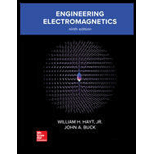
Engineering Electromagnetics
9th Edition
ISBN: 9780078028151
Author: Hayt, William H. (william Hart), Jr, BUCK, John A.
Publisher: Mcgraw-hill Education,
expand_more
expand_more
format_list_bulleted
Concept explainers
Textbook Question
Chapter 7, Problem 7.16P
A current filament carrying I in the -az direction lies along the entire positive z axis. At the origin, it connects to a conducting sheet that forms the xy plane. (a) Find K in the conducting sheet. (b) Use Ampere' s circuital law to find H everywhere for z > 0. (c) Find H for z < 0.
Expert Solution & Answer
Want to see the full answer?
Check out a sample textbook solution
Students have asked these similar questions
In a material medium with relative dielectric constant LaTeX: \ varepsilon_r = 3 & varepsilon; r = 3, LaTeX: 5 \ mu C5μC load LaTeX: R = 2mR = 2m radius is uniformly distributed over the sphere volume. Accordingly, which of the following is the expression of electric field outside the sphere.
A current element currying 20 mA in a az direction lies along the entire z axis. Find H in
rectangular coordinates at : (a) PA(20,0,4), (b) PB(2,-4,4).
There are point loads ,Q1 = 5, Q2 = 8 and Q3 = 6 at points A(-8,0), O(0,0) and B (6,0) in the OXY plane, respectively.Write the value of the x-component of the electric field in ke numerically at the point P(0, 10) on the-axis.
Chapter 7 Solutions
Engineering Electromagnetics
Ch. 7 - Find H in rectangular components at P(2,3,4) if...Ch. 7 - Prob. 7.2PCh. 7 - Prob. 7.3PCh. 7 - Prob. 7.4PCh. 7 - The parallel filamentary conductors shown in...Ch. 7 - A disk of radius a lies in the xy plane, with z...Ch. 7 - Prob. 7.7PCh. 7 - For the finite-length current element on the z...Ch. 7 - Prob. 7.9PCh. 7 - Prob. 7.10P
Ch. 7 - A solenoid of radius a and of length. L is...Ch. 7 - Prob. 7.12PCh. 7 - Prob. 7.13PCh. 7 - Prob. 7.14PCh. 7 - Prob. 7.15PCh. 7 - A current filament carrying I in the -az direction...Ch. 7 - Prob. 7.17PCh. 7 - Prob. 7.18PCh. 7 - Prob. 7.19PCh. 7 - A solid conductor of circular cross section with a...Ch. 7 - Prob. 7.21PCh. 7 - Prob. 7.22PCh. 7 - Prob. 7.23PCh. 7 - Prob. 7.24PCh. 7 - Prob. 7.25PCh. 7 - Prob. 7.26PCh. 7 - The magnetic field intensity is given in a certain...Ch. 7 - Given H=(3r2/sin)a+54rcosa A/m in free space: (a)...Ch. 7 - Prob. 7.29PCh. 7 - Prob. 7.30PCh. 7 - Prob. 7.31PCh. 7 - Prob. 7.32PCh. 7 - Use an expansion in rectangular coordinates to...Ch. 7 - A filamentary conductor on the z axis carries a...Ch. 7 - A current sheet K = 20 az A/m, is located at p =...Ch. 7 - Let A= (3y-z)ax+2xzayWb/m in a certain regin of...Ch. 7 - Let/N=1000, I=.08 A, p0=2 cm and a=.08 cm for the...Ch. 7 - A square filamentary differential current loop, dL...Ch. 7 - Prob. 7.39PCh. 7 - Show that the line integral of the vector...Ch. 7 - Prob. 7.41PCh. 7 - Show that 2(1/R12)=1(1/R12)=R21/R312.Ch. 7 - Compute the vector magnetic potential within the...Ch. 7 - Prob. 7.44P
Knowledge Booster
Learn more about
Need a deep-dive on the concept behind this application? Look no further. Learn more about this topic, electrical-engineering and related others by exploring similar questions and additional content below.Similar questions
- There are point loads ,Q1 = 5, Q2 = 8 and Q3 = 6 at points A(-8,0), O(0,0) and B (6,0) in the OXY plane, respectively. Write the value of the x-component of the electric field in ke numerically at the point P(0, 10) on the-axis.arrow_forwardConsider region 1 (z<0) contains a dielectric for which ϵr=2.5, and region 2 (z>0) is characterized by ϵr=4 .Let E1=−30ax+50ay+70az V/m. The D2 is given byarrow_forwardThere are point loads Q1= 4, Q2=9 and Q3=4 at points A(-7,0), O(0,0) and B (4,0) in the OXY plane, respectively. Write the value of the y-component of the electric field in terms of ke numerically at the point P(0, 13) on the-axis.arrow_forward
- A thin ring of radius 5 cm is placed on plane z = 1 cm so that its center is at (0,0,1 cm). If the ring carries 50 mA along aф, find H at ( 0 , 0 , - l c m )arrow_forwardDesign a uniformly-stressed coaxial cylindrical electrode system using threedifferent insulating materials with relative dielectric constants 2.5, 4, and 6(determine the layer thicknesses for the inner and outer radiuses of case-a).Calculate the maximum field strength of the layers for a test voltage of U = 200 kV.arrow_forwardAn infinite length cylinder of radius b extending along the Z-axis and carrying auniform volumetric current density J= az J, a cylindrical cavity of radius ? ismade along the entire length of the cylinder such that its axis is displaced adistance ? from the axis of the main cylinder, as shown in the figure.Use superposition (by handling the cavity as a cylinder carrying current –Jsuperimposed on the main current J that fill the entire cross section) to findthe magnetic flux density inside the cavityarrow_forward
- Q3/Given the current density J = 60 pa, A/m in cylindrical coordinates: (a) Determine the magnetic field H, where H varies with p only and has only a 0 component; (b) integrate J over the circular surface p = 1,0< 0< 2n, z 0, to determine the total current passing through that surface in the a, direction ; (c) find the total current using a line integral around the circular path p = 1, 0< 0< 2n, z = 0.arrow_forwardA sheet of charge, ρS = 2nC/m2, is pressed at the plane x = 3 in free space, and a line charge, ρL = 20nC/m, is located at x = 1, z = 4. Find the magnitude of the electric field intensity at the origin. (Hint: E = ES + EL)arrow_forwardThe polarization vector in a dielectric tube of inner radius ri and outer radius ro is ?⃗ = ?0(?̂?2? + ?̂?3?). Theaxis of the dielectric tube defined by z0>z>0 coincides with the z-axis. a) Determine the equivalent polarization surface and volume charge densitites. b) Show that the total bound charge is zero.arrow_forward
- It is viewed from the cross-section of a coaxial cable consisting of a cylindrical conductive tube with an internal radius R and an outer radius of Rz wrapped around a cylindrical conductive wire with a RADIUS of R. r to indicate the radial distance from the center, the inner cylindrical conductor,if it is j1 = Gr and the outer conductive tube, j2 = Car has improper current densities. Here, the two conductors carry the same I flow in zit directions. What is the size of the B2 magnetic fields at r=1 cm and B2 at r= 8 cm?(R=4 cm; R=7 cm, R3=9 cm; Io=2 A; uo=47.10-7 T.m/A and our aquani-positive forehead outward from the page plane).arrow_forwardCalculate D at point (12, -2, 7), produced by a uniform line charge 20 mC/m on x axis.arrow_forwardPlease answer and write neatly. (Show your complete solution.) Volume charge density is located in free space as ρν = 2e−1000r nC/m3for 0 < r < 1 mm, and ρν = 0elsewhere.(a) Find the total charge enclosed by the spherical surface r = 1 mm.(b) By using Gauss’s law, calculate the value of Dr on the surface r = 1 mm.arrow_forward
arrow_back_ios
arrow_forward_ios
Recommended textbooks for you
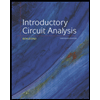 Introductory Circuit Analysis (13th Edition)Electrical EngineeringISBN:9780133923605Author:Robert L. BoylestadPublisher:PEARSON
Introductory Circuit Analysis (13th Edition)Electrical EngineeringISBN:9780133923605Author:Robert L. BoylestadPublisher:PEARSON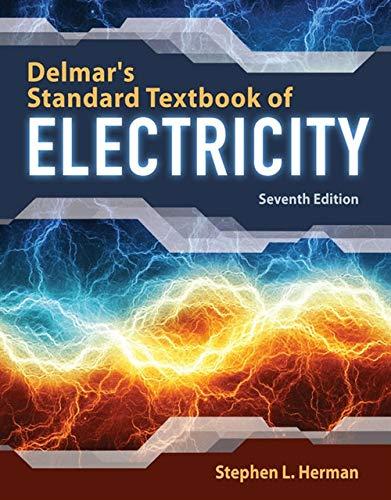 Delmar's Standard Textbook Of ElectricityElectrical EngineeringISBN:9781337900348Author:Stephen L. HermanPublisher:Cengage Learning
Delmar's Standard Textbook Of ElectricityElectrical EngineeringISBN:9781337900348Author:Stephen L. HermanPublisher:Cengage Learning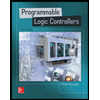 Programmable Logic ControllersElectrical EngineeringISBN:9780073373843Author:Frank D. PetruzellaPublisher:McGraw-Hill Education
Programmable Logic ControllersElectrical EngineeringISBN:9780073373843Author:Frank D. PetruzellaPublisher:McGraw-Hill Education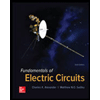 Fundamentals of Electric CircuitsElectrical EngineeringISBN:9780078028229Author:Charles K Alexander, Matthew SadikuPublisher:McGraw-Hill Education
Fundamentals of Electric CircuitsElectrical EngineeringISBN:9780078028229Author:Charles K Alexander, Matthew SadikuPublisher:McGraw-Hill Education Electric Circuits. (11th Edition)Electrical EngineeringISBN:9780134746968Author:James W. Nilsson, Susan RiedelPublisher:PEARSON
Electric Circuits. (11th Edition)Electrical EngineeringISBN:9780134746968Author:James W. Nilsson, Susan RiedelPublisher:PEARSON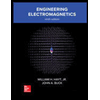 Engineering ElectromagneticsElectrical EngineeringISBN:9780078028151Author:Hayt, William H. (william Hart), Jr, BUCK, John A.Publisher:Mcgraw-hill Education,
Engineering ElectromagneticsElectrical EngineeringISBN:9780078028151Author:Hayt, William H. (william Hart), Jr, BUCK, John A.Publisher:Mcgraw-hill Education,

Introductory Circuit Analysis (13th Edition)
Electrical Engineering
ISBN:9780133923605
Author:Robert L. Boylestad
Publisher:PEARSON

Delmar's Standard Textbook Of Electricity
Electrical Engineering
ISBN:9781337900348
Author:Stephen L. Herman
Publisher:Cengage Learning

Programmable Logic Controllers
Electrical Engineering
ISBN:9780073373843
Author:Frank D. Petruzella
Publisher:McGraw-Hill Education

Fundamentals of Electric Circuits
Electrical Engineering
ISBN:9780078028229
Author:Charles K Alexander, Matthew Sadiku
Publisher:McGraw-Hill Education

Electric Circuits. (11th Edition)
Electrical Engineering
ISBN:9780134746968
Author:James W. Nilsson, Susan Riedel
Publisher:PEARSON

Engineering Electromagnetics
Electrical Engineering
ISBN:9780078028151
Author:Hayt, William H. (william Hart), Jr, BUCK, John A.
Publisher:Mcgraw-hill Education,
Demos: Dielectric breakdown; Author: Caltech's Feynman Lecture Hall;https://www.youtube.com/watch?v=2YrHh1ikefI;License: Standard Youtube License